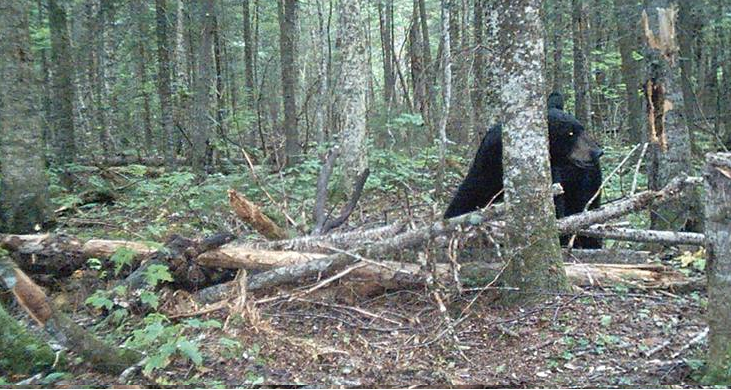This winter I had the privilege of chatting with Richard P. Smith, outdoor writer/photographer, just before he headed off to a speaking engagement at an outdoor hunting and fishing show. Most know Richard for being an expert hunter, scoring many book bucks and bears. Because of his time outdoors, I classify him as a bear and deer behavior expert…with a wealth of information.
Gary L. Morgan (GLM): After hunting for over 50 years, scoring several book bears, what can you share with our bear hunters…whether a first timer or having hunted for years?
Richard P. Smith (RPS): The most valuable information to start with, from my perspective, is to (know) about the baits you used.
GLM: (In 2013) we used restaurant scraps with a dose of used cooking oil. In 2014 we switched to sticky granola (1 gallon, or less).
RPS: Based on my experience, you have been reducing the effectiveness of your baiting by using such a small quantity of food during each visit. Using a larger quantity of food is necessary if you want to increase the chances of having multiple bears on baits. The most successful bear baiters I know use a few gallons of bait at each site every 1 or 2 days. If more than 2 days elapses between visits, a larger quantity of bait should be used. (check with your state game laws for baiting restrictions.)
GLM: In 2014 our thoughts were to use something that did not require refrigeration & hoped the chocolate would deter canines.
RPS: Granola is great for bear bait, but I know wolves also eat it. Baits should be either covered with large logs that are too big for raccoons to move or put in hollow stumps and covered with rocks too heavy for raccoons to move. By covering baits in this fashion, it also prevents wolves from getting at the bait until a bear opens it.
RPS: How often did you check your baits?
GLM: Our initial bait was about three weeks before the Sept 10th opener…baiting about every 5 days til the day after Labor Day..then baiting every day. We continued to bait each day when hunters were on sites…thus, we walked in with each hunter, having the hunter stay away from bait.
RPS: When baiting before hunting season you want to feed as many bears as possible and encourage them to return often. Baiting daily and in large quantity is ideal.
GLM: Three-fourths of our baits are a mile walk, or more, each way. We wanted (our clients) to hunt (mature) bears that are away from human activity. One of our challenges was to thwart the raccoons, not allowing them to get to the bait. Without trail cameras there were times we could not tell if a family of raccoons or a bear or both hit the bait.
RPS: When I select bait sites, I always look for bear sign & try to make sure a natural bear food source is in the area.
GLM: A number of our bait sites were experiencing bears circling around the entire area to catch wind of the hunter in the blind, thus, changing the bruins mind to come to the bait.
RPS: When replenishing bait at sites, use heavy rubber gloves when handling logs, rocks, etc. Minimize human scent. Because you’re sites are remote, you’re hunting mature bears. You can fool some of them by going to tree stands. However, it is critical that hunters be as scent free as possible, utilize scent elimination clothing and sprays.
Note: We really appreciated our chance to chat with Richard P. Smith. I would urge anyone (experienced, otherwise) who bear hunts to pick up a copy of his book, Black Bear Hunting, 2nd edition. One extra tip I pick up was to refrain from putting out a bear hunting stand or blind until the day before or preferably the day of your hunt. I would strongly agree. One of our hunters successfully bagged his nice 240 lb bruin utilizing this very method (story soon to follow).
Note: We really appreciated our chance to chat with Richard P. Smith. I would urge anyone (experienced, otherwise) who bear hunts to pick up a copy of his book, Black Bear Hunting, 2nd edition. One extra tip I pick up was to refrain from putting out a bear hunting stand or blind until the day before or preferably the day of your hunt. I would strongly agree. One of our hunters successfully bagged his nice 240 lb bruin utilizing this very method (story soon to follow).
Latest posts by Wild Game Dynasty (see all)
- Are Ruffed Grouse Toxic?Maybe Sometimes - March 18, 2022
- The Hunter, The Dreamer - January 19, 2022
- Are You Scouting For Success? - January 19, 2022

